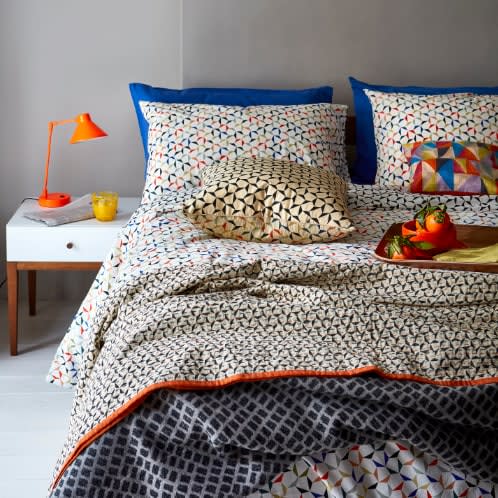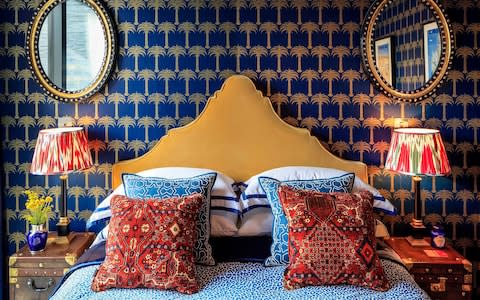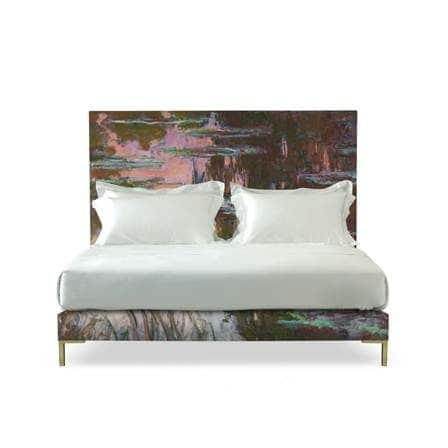Could the design of your bedroom help you get more sleep?

The bedroom is often a rather neglected part of the house when it comes to interior design - we may spend a third of our lives in bed, but most of us spend more of our money and energy on decorating more ‘public’ areas, such as the kitchen and sitting room. The concept of well-being in the home is, however, increasingly filtering into interior design, as is the idea of using decor to promote better sleep.
Yesterday marked the start of National Bed Month, the Sleep Council’s annual sleep awareness campaign, so if your bedroom is looking a little tired, now is as good a time as any to give it a design refresh.
Layout is key to achieving a sense of calm in a bedroom, and according to London-based architect Rodrigo Moreno Masey, it’s all about going back to your roots and channelling your inner cave-dweller: “Make sure you’re facing the door when you’re in bed, so that you don’t have a sense that someone could be coming into the room beside or behind you, and avoid ‘floating’ a bed in a room without something substantial behind it,” he advises. To maximise a feeling of flow in the room, he also suggests choosing a bed on legs, rather than a divan, so that the flooring runs underneath. “Try to remove all functions from the bedroom besides sleeping and relaxing - even dressing, if you can,” he adds. “It moves the chaos out of the room.”
When it comes to decoration, the received wisdom is that a calm, zen-like space is most conducive to a good night’s sleep - but some designers are turning towards using colour and pattern to lift the mood and create a restful ambience.

Interior designer Lucy Barlow (barlowandbarlow.com) advises against going for an all-white bedroom in a northern climate: “The result can be very cold and stark,” she says. “An off-white is more inviting, but colour can have a huge impact on our mood. Green, blue, yellow and pink are known to have a relaxing effect, and are therefore perfect for the bedroom. We often go one step further and use textured wallcoverings in our clients’ bedrooms, sometimes in silk or linen, for ultimate warmth and cosiness.”
Similarly, interior designer Tara Bernerd (tarabernerd.com), who creates hotel rooms for the Thompson and Four Seasons groups, suggests a layered design to create warmth and atmosphere. “Texture is key to achieving this,” she says, “and fabrics form an integral part of the process: from tweed and corduroys in cooler locations to soft flannels or textured linens in warmer climates.”

If you’re inspired to go for a colourful, maximalist look in your bedroom, try dressing your bed with reversible bedlinen and loading it with blankets, throws and cushions in contrasting patterns - Habitat has a good selection in its spring collections. Likewise, new French bedding brand Blanc Cerise, whose founder, Fabienne Motteroz, believes that colour and material are closely linked to well-being, does a good line in raw cotton and linen bedding in bold blues, greens and reds.
For the ultimate in statement-making beds, Andrew Martin has teamed up with Savoir Beds and the National Gallery, with a licence to reproduce any painting in the gallery’s permanent collection on headboard and bed base upholstery - literally turning the bed into a work of art.

If a more muted take on colour is more to your taste, the recently launched Piglet in Bed specialises in natural stonewashed linen in tasteful tones such as sage, indigo, dove grey and blush pink, which softens with washing and is ideal for iron-phobes, being suited to a slightly crumpled look. “What makes linen stand out is how fantastic it looks on a loosely made bed: the folds and creases create a beautiful texture,” says founder Jessica Mason, whose Instagram feed is packed with pictures of artfully arranged beds.
Once you’ve nailed down layout and decor, lighting is vital in creating a somnolent space - harsh, too-bright light in the evening can interfere with the body’s circadian rhythm. “Good lighting can be mood enhancing, and bedroom lighting is especially important,” says interior designer Sophie Ashby (studioashby.com). “All lights should be dimmable, and low-level lighting is more ambient, flattering and atmospheric. In a bedroom, I would rely on table lamps, floor lamps and wall lights rather than spotlights; a combination of vertical uplighting and downlighting is best.”
How to make the best of your bed
The Mattress
On choosing your mattress, it’s important to try before buy, says Adam Black, co-founder of bedmaker Button & Sprung. “When lying on your back there should be no gap under your lower back. A mattress that is too firm will not receive your shoulders and hips and will have the ‘park bench’ effect, while a mattress too soft will do the opposite and operate like a hammock.” Black advises choosing a mattress filled with natural fibres such as wool and hemp, which help to regulate body temperature.
The Duvet
When it comes to duvets, microfibre is a good choice for allergy sufferers, while a natural filling will last longer and, again, help your skin to “breathe” while you sleep. “Don’t confuse weight with warmth, as a top-quality down duvet may feel very light but has extremely effective thermal properties,” says Nayna Bhayani, a buyer at John Lewis’s bedroom department, who suggests checking for “fill power rating” on a down duvet, which relates to the volume or fluffiness of filling: the higher the rating, the warmer and bouncier the duvet. If you and your partner have different duvet requirements, try John Lewis’s Duvet Menu service, which allows you to customise all elements.
The Pillow
Your sleeping position should determine your choice of pillow - back-sleepers will need a flatter pillow to keep the neck aligned, while a side-sleeper will be more comfortable with a plumper pillow that fills the gap between head and neck. Memory foam could be helpful for those needing more neck support, but can lead to overheating, so latex is a better choice to cut down on night sweats. For the ultimate in softness, down is the luxe choice.

 Yahoo News
Yahoo News 